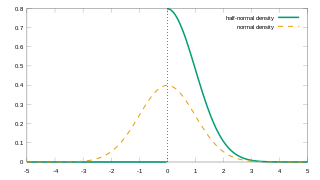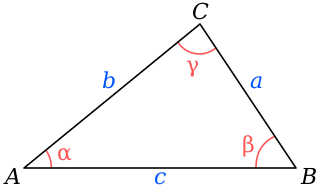
In probability theory and statistics, the gamma distribution is a two-parameter family of continuous probability distributions. The exponential distribution, Erlang distribution, and chi-square distribution are special cases of the gamma distribution. There are two different parameterizations in common use:
- With a shape parameter k and a scale parameter θ.
- With a shape parameter α = k and an inverse scale parameter β = 1/θ, called a rate parameter.
In mathematical logic, a sequent is a very general kind of conditional assertion.

In mathematical logic and type theory, the λ-cube is a framework introduced by Henk Barendregt to investigate the different dimensions in which the calculus of constructions is a generalization of the simply typed λ-calculus. Each dimension of the cube corresponds to a new kind of dependency between terms and types. Here, "dependency" refers to the capacity of a term or type to bind a term or type. The respective dimensions of the λ-cube correspond to:
In linguistics, focus is a grammatical category that conveys which part of the sentence contributes new, non-derivable, or contrastive information. In the English sentence "Mary only insulted BILL", focus is expressed prosodically by a pitch accent on "Bill" which identifies him as the only person Mary insulted. By contrast, in the sentence "Mary only INSULTED Bill", the verb "insult" is focused and thus expresses that Mary performed no other actions towards Bill. Focus is a cross-linguistic phenomenon and a major topic in linguistics. Research on focus spans numerous subfields including phonetics, syntax, semantics, pragmatics, and sociolinguistics.
In mathematics, a matrix norm is a vector norm in a vector space whose elements (vectors) are matrices.

In probability theory and statistics, the inverse gamma distribution is a two-parameter family of continuous probability distributions on the positive real line, which is the distribution of the reciprocal of a variable distributed according to the gamma distribution.

In probability and statistics, the Kumaraswamy's double bounded distribution is a family of continuous probability distributions defined on the interval (0,1). It is similar to the Beta distribution, but much simpler to use especially in simulation studies since its probability density function, cumulative distribution function and quantile functions can be expressed in closed form. This distribution was originally proposed by Poondi Kumaraswamy for variables that are lower and upper bounded with a zero-inflation. This was extended to inflations at both extremes [0,1] in later work with S. G. Fletcher.
In mathematics, Riemann's differential equation, named after Bernhard Riemann, is a generalization of the hypergeometric differential equation, allowing the regular singular points to occur anywhere on the Riemann sphere, rather than merely at 0, 1, and . The equation is also known as the Papperitz equation.
The normal-inverse Gaussian distribution (NIG) is a continuous probability distribution that is defined as the normal variance-mean mixture where the mixing density is the inverse Gaussian distribution. The NIG distribution was noted by Blaesild in 1977 as a subclass of the generalised hyperbolic distribution discovered by Ole Barndorff-Nielsen. In the next year Barndorff-Nielsen published the NIG in another paper. It was introduced in the mathematical finance literature in 1997.

A biarc is a smooth curve formed from two circular arcs. In order to make the biarc smooth, the two arcs should have the same tangent at the connecting point where they meet.
In programming language semantics, normalisation by evaluation (NBE) is a style of obtaining the normal form of terms in the λ-calculus by appealing to their denotational semantics. A term is first interpreted into a denotational model of the λ-term structure, and then a canonical representative is extracted by reifying the denotation. Such an essentially semantic approach differs from the more traditional syntactic description of normalisation as a reductions in a term rewrite system where β-reductions are allowed deep inside λ-terms.

In probability theory and statistics, the half-normal distribution is a special case of the folded normal distribution.

In probability theory and statistics, the normal-inverse-gamma distribution is a four-parameter family of multivariate continuous probability distributions. It is the conjugate prior of a normal distribution with unknown mean and variance.

In trigonometry, the law of cosines relates the lengths of the sides of a triangle to the cosine of one of its angles. Using notation as in Fig. 1, the law of cosines states
We take the functional theoretic algebra C[0, 1] of curves. For each loop γ at 1, and each positive integer n, we define a curve called n-curve. The n-curves are interesting in two ways.
- Their f-products, sums and differences give rise to many beautiful curves.
- Using the n-curves, we can define a transformation of curves, called n-curving.
In mathematics, Ricci calculus constitutes the rules of index notation and manipulation for tensors and tensor fields on a differentiable manifold, with or without a metric tensor or connection. It is also the modern name for what used to be called the absolute differential calculus, developed by Gregorio Ricci-Curbastro in 1887–1896, and subsequently popularized in a paper written with his pupil Tullio Levi-Civita in 1900. Jan Arnoldus Schouten developed the modern notation and formalism for this mathematical framework, and made contributions to the theory, during its applications to general relativity and differential geometry in the early twentieth century.
Revision theory is a subfield of philosophical logic. It consists of a general theory of definitions, including circular and interdependent concepts. A circular definition is one in which the concept being defined occurs in the statement defining it—for example, defining a G as being blue and to the left of a G. Revision theory provides formal semantics for defined expressions, and formal proof systems study the logic of circular expressions.
In linguistics, a subsective modifier is an expression which modifies another by delivering a subset of its denotation. For instance, the English adjective "skilled" is subsective since being a skilled surgeon entails being a surgeon. By contrast, the English adjective "alleged" is non-subsective since an "alleged spy" need not be an actual spy.
In linguistics, a privative adjective is an adjective which seems to exclude members of the extension of the noun which it modifies. For instance, "fake" is privative since a "fake nose" is not an actual nose. Other examples in English include "pretend", "fictitious", and "artificial". The defining feature of privative adjectives is shown below in set theoretic notation.
- An adjective is privative if for any noun , we have that .
In mathematics, Rathjen's psi function is an ordinal collapsing function developed by Michael Rathjen. It collapses weakly Mahlo cardinals to generate large countable ordinals. A weakly Mahlo cardinal is a cardinal such that the set of regular cardinals below is closed under . Rathjen uses this to diagonalise over the weakly inaccessible hierarchy.














